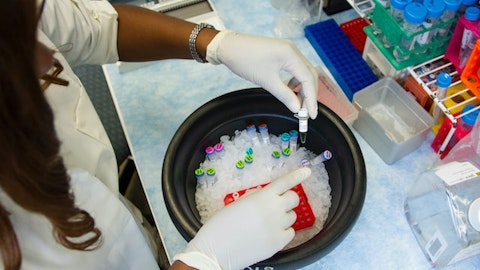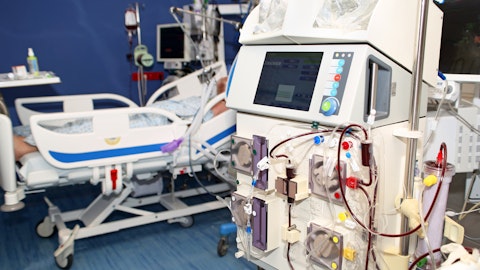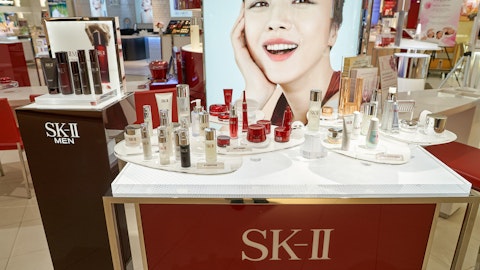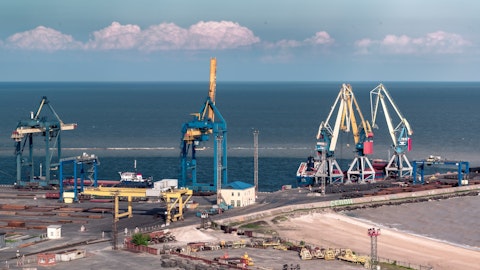Establishment Labs Holdings Inc. (NASDAQ:ESTA) Q3 2023 Earnings Call Transcript November 7, 2023
Establishment Labs Holdings Inc. misses on earnings expectations. Reported EPS is $-1.12 EPS, expectations were $-0.72.
Operator: Good afternoon. Welcome to Establishment Labs’ Third Quarter 2023 Earnings Call. At this time, all participants will be in a listen-only mode. At the end of this call, we will open the line for questions-and-answers session and instructions will follow at that time. As a reminder, today’s call is being recorded. I will now turn the call over to Raj Denhoy, Chief Financial Officer. Please go ahead.
Raj Denhoy: Thank you, operator and thank you, everyone for joining us. With me today is Juan Jose Chacon Quiros, our Chief Executive Officer. Following our prepared remarks, we’ll take your questions. Before we begin, I would like to remind you that comments made by management during this call will include forward-looking statements within the meaning of federal securities laws. These include statements on Establishment Labs’ financial outlook, and the company’s plans and timing for product development and sales. These forward-looking statements are based on management’s current expectations and involve risks and uncertainties. For a discussion of the principal risk factors and uncertainties that may affect our performance or cause actual results to differ materially from these statements, I encourage you to review our most recent annual and quarterly reports on Form 10-K and Form 10-Q, as well as other SEC filings, which are available on our website at establishmentlabs.com.
Please also note that Establishment Labs received an investigational device exemption from the FDA for Motiva Implants and is undergoing a clinical trial to support regulatory approval in the United States. We continually seek to expand the geographies, in which our products are regulatory approved. Please check with your local authority for specific product availability. The content of this conference call contains time-sensitive information accurate only as of the data this live broadcast, November 7, 2023. Except as required by law, Establishment Labs undertakes no obligation to revise or otherwise update any statement to reflect events or circumstances after the date of this call. With that, it is my pleasure to turn the call over to our CEO, Juan Jose.
Juan Jose Chacon Quiros: Thank you, Raj and good afternoon, everyone. Revenue in the third quarter of 2023 totaled $38.5 million in line with the third quarter of 2022. Our results this quarter reflect that lower demand for breast procedures globally. This lower demand developed over the quarter in our direct markets and was also reflected in orders we received from our distributors, and we expect this trend will persist in the fourth quarter. As such, we are lowering our full-year guidance to approximately $165 million, representing annual growth of 2% over 2022. I would note that while we still expect China approval by the end of this year, we have removed it from our guidance as we have less than two months remaining in this year.
This is a meaningful portion of our reduction in guidance. However, even in this period, we continue to gain accounts around the world. This slowdown seems fairly broad across aesthetics and does not seem to be related to anything specific in the breast implant industry. While anecdotal, in international markets, both plastic surgeons and dermatologists report to us, they have seen a noticeable slowdown in their practices across all procedure types, both surgical and non-surgical. This is, of course, not a first for the aesthetics industry, and both precedent and our experience suggests that this will be transitory and relatively short-lived. That said, we are being very careful in this environment and we have taken steps to make sure our business is spending a relation to the current demand among the steps we are taking are a reduction in global headcount and a reduction in operating expenses.
We are also prioritizing our main growth initiatives, the United States, China and Mia, as well as cautiously managing our global inventory levels. Even as we take these steps, we expect growth to resume in 2024, which includes doubling our TAM to our entry into the United States and China. Our access to capital is a significant advantage here and we are positioning ourselves to take advantage as demand inevitably returns to our industry. There has been worldwide dislocation in the competitive markets for breast implants and this presents a sizable opportunity. It is also important to note that we continue to grow our market share. Our internal data shows that we continue to gain surgeon accounts in our markets and our competitive positioning is strengthening.
We are taking market share globally and this should continue through the remainder of 2023 and into 2024. We are raising the standard of what women and surgeons should expect from the technologies they choose and we are distancing ourselves from the remaining players in this industry. Our pipeline of new products and new geographic markets will help fuel our momentum, and we have a very solid foundation, on which to build for 2024 and beyond. Raj will provide additional details on our third quarter performance and our outlook in a moment. But I would like to highlight that we expect to be EBITDA-positive by the end of 2024 and cash-flow positive in 2025. These are corporate goals that are reflected throughout our business planning and are of the utmost priority.
On October 15th, we announced that the U.S. FDA granted 510(k) clearance for the Motiva Flora SmoothSilk Tissue Expander. This was a major milestone for the company as it is our first implantable approved for the United States. Flora offers several proprietary and unique innovations including Establishment Labs patented SmoothSilk surface technology. SmoothSilk was the subject of the landmark paper published in Nature Biomedical Engineering by MIT scientist, Bob Langer, in which the surface was shown to be the most biocompatible, compared to other implantable surfaces. Flora also includes an RFID-enabled non-magnetic port and is labeled as MRI conditional by the FDA. By being magnet-free, Flora avoids the interference that magnets cause during MR imaging and can improve the precision of radiation oncology treatment.
This is a distinct advantage to Flora as all other commercially-available breast tissue expanders include magnets. In the FDA’s letter of the Flora approval, the agency noted, this is an innovative technology not available in other tissue expanders on the market. Flora has been available outside the U.S. since 2021 and we are gaining traction with the device. There have been several notable independent publications highlighting improved patient comfort with Flora, compared to other devices, and improved imaging and radiation treatment outcomes. Despite one in eight women developing breast cancer, tissue expanders have seen little innovation in decades. With Flora, we are providing surgeons and the women who receive these devices a better option.
We are extremely proud of being able to offer Flora to women in the United States. We began to introduce Flora to plastic surgeons in the United States at the Annual Meeting of the American Society of Plastic Surgeons in Austin at the end of October. And the reception was highly encouraging. Leading plastic surgeons at some of the top institutions in America have indicated that they will begin to adopt Flora as their expander of choice. In October, we held our eighth world symposium on Ergonomix Implants in Lisbon, Portugal. Among the highlights was a presentation of two-year results from the Mia Feasibility Clinical Study. The Mia study is an IRB-approved prospective study that enrolled the first 100 subjects between December 2020 and April 2021.
In the preliminary two-year Kaplan-Meier analysis of key events, there were no reports of capsule contracture and no ruptures. A sub-study of 33 subjects, who underwent an MRI at 18 months also showed no ruptures. There were no reports of bleeding, hematoma, or seroma requiring intervention in the study. These are among the best results shown at two years for any breast implant technology and add further support that Mia Femtech is an entirely new category within breast aesthetics. With Mia, a plastic surgeon can shape the breast in a 15-minute, minimally invasive procedure without the need for general anesthesia. The result is natural and discrete, with a one-to-two cup proportionate result. The procedure requires minimal downtime with women returning to most activities the same day by providing a solution that overcomes many of the obstacles of traditional breast augmentation, we are opening up a whole new group of women to breast aesthetics.

Our list of countries, where Mia is available continues to grow. We have partner sites in Spain, Switzerland, Sweden, Germany, France, Costa Rica and Japan. And we have partnered with our distributors in Turkey and the Middle East to begin opening sites in those regions in 2024. It is early in the launch of Mia, but we are seeing proof points that we are creating and capturing demand for this new category. One recent Mia consumer is Yokasta Valle. Yoka is a professional female boxer. And just this past weekend, she defended her International Boxing Federation and World Boxing Organization mini-flyweight titles by unanimous decision. Yoka has now defended her world titles twice just months since her Mia procedure. She’s not only an inspiration as a world-class athlete, but is also a testament to how women can quickly return to their lives with Mia without limitation or restrictions.
Already, we have reports of women flying internationally from the United States to receive the procedure abroad. In some cases, they are paying in excess of $20,000 for a premium experience. This is more than twice the cost of the average breast augmentation in the United States. Stories like these demonstrate that not only is this a new category in breast aesthetics, but that Mia is going to be firmly into luxury category and highly aspirational. The momentum for Mia continues to build, and both awareness and lead generation continue to grow. This will eventually be converted into more procedures taking place at our Mia-certified partnered clinics. The launch of a new platform like Ergonomix2, which include the implants for JOY and Mia, is an opportunity to price technology according to consumers’ willingness to pay.
Thus, we are glad to see the contribution toward total revenue of the JOY program now exceed 10% of our total implant revenue with an average selling price of more than double our blended rounded Ergonomix pricing. We are beginning to see positive contribution to our gross margins from this platform. As JOY and Mia scale, ASP and gross margins will improve in the international markets. The United States and China have the highest prices in the world and would be significantly accretive to ASP and gross margins. All of this together lays the foundation for a very strong company. We are actively preparing for the launch of Motiva in China with our distribution partner as we await for the letter of approval from the NMPA for Motiva implants. In the U.S., the final module of our PMA was submitted to the FDA in the first quarter of 2023 and the full PMA remains on the review by the agency.
The pace of activity and our interactions with the agency remains very positive. It is notable that while the recent approval of Flora and the approval of Motiva are separate processes, the devices share the same surface technology, similar RFID technology in our manufacture under the same conditions at the same facility. We recently hired Elizabeth Panzica Newman to lead our U.S. business. Liz brings over 30 years of experience launching and growing aesthetic brands. She is moving quickly to build out the commercial and operational teams in its finalizing plans for launch. We look forward to sharing more with you about our progress over the coming months. Our confidence that Motiva Implants will soon be available to women in the United States continues to grow.
I will now turn the call over to Raj.
Raj Denhoy: Thank you, Juan Jose. Total revenue for the third quarter was $38.5 million, which was growth of 0.8%. From a regional perspective, sales in Europe, Middle East and Africa were approximately 61% of the global total, Asia Pacific was 6% and Latin America 33%. Direct sales were approximately 54% of implant sales while distributors made up the balance. Brazil, which is our single largest market globally, accounted for approximately 16% of total quarterly sales. Our gross profit for the third quarter was $26.1 million or a 67.7% of revenue, compared to $26 million or a 68.1% of revenue for the same period in 2022. Our gross profit in the third quarter was positively impacted by increased contribution of Mia revenue. This was partially offset by higher overhead and labor costs.
Costs were higher in part from changes in exchange rates between the U.S. dollar and the Costa Rica colon. As a report in U.S. dollars, the revaluation of the colon over the last year resulted in higher costs in the period. Average selling price is in the third quarter up from the second quarter of 2023 and year-over-year. SG&A expenses for the third quarter increased approximately $8.7 million to $40 million, compared to $31.3 million in the third quarter of 2022. The increase in SG&A in the third quarter resulted in part from our investments in new growth initiatives like Mia and preparations for a launch in the U.S. R&D expenses for the third quarter increased approximately $1.8 million in the same quarter a year ago to $7.1 million. Higher personnel costs and increased activities related to our U.S. approval processes contributed to the higher spending this period.
Total operating expenses for the third quarter were $47.1 million, an increase of approximately $10.5 million from the year-ago period. Net loss from operations of the third quarter was $29.3 million, compared to a net loss of $18.6 million in the same period of 2022. Our cash position as of September 30th was $52.2 million, compared to $66.4 million at the end of 2022. Our cash use in the third quarter included approximately $6.6 million of investments in CapEx, including for a new manufacturing facility, which is now complete, as well as a $13.9 million increase in inventory as we prepare for the launches of Motiva in China and the United States. As a reminder, we have two remaining tranches in our debt facility, which totaled $50 million and which become available on the achievement of sales and regulatory milestones.
These, along with the cash on hand at the end of the third quarter, provide us with access to approximately $100 million in capital. As Juan Jose noted, we are lowering full-year revenue guidance to approximately $165 million. The updated guidance reflects lower demand globally, but also that we removed China from our forecast. We expect approval in China this quarter, but at this late point in the year, we are not forecasting any revenue contribution in 2023. The reduction in guidance is approximately two thirds from the changes in demand and one third from China timing. We continue to expect gross margin in 2023 to be approximately 100 basis points lower than 2022. We are taking steps to control expenses in cash use. This includes a target of 20% reduction in global personnel costs, focus reductions in operating expenses and management of inventory levels.
As a result, we expect cash use in the fourth quarter to be meaningfully lower than in the third quarter. Our objectives to reduce cash use to less than $15 million in the fourth quarter and based upon the actions we have taken thus far; we are confident we will meet this target. With these actions, we expect to be EBITDA-positive in 2024 and cash-flow positive in 2025. We believe we can achieve these targets with the cash we have on hand and with additional credit available to us. These are very important core objectives for Establishment Labs and will be reflected in our corporate planning, as well as in our compensation structure for employees. I will now turn the call back to Juan Jose.
Juan Jose Chacon Quiros: Thank you, Raj. Establishment labs is taking share and we expect to continue to do so. The clinical and scientific data supporting the use of our products is unprecedented and only grows stronger, and you are seeing this affect many of our competitors. With our entries into the U.S. and China, we will double our addressable markets and we are poised to become the leading global company in breast aesthetics and reconstruction. Over the next few years, we will continue to transform and expand our markets by creating new categories with innovations like Mia. We are very excited about our future and expect strong growth for many years to come. Our 2026 target of $500 million in revenue remains a key long-term corporate objective and everything I see suggests we will be successful. I will now turn the call over to the operator for your questions.
Operator: [Operator Instructions] Your first question comes from the line of Matt Taylor from Jefferies. Please go ahead.
See also 15 Best American Dividend Stocks To Buy Now and 13 Best Affordable Dividend Stocks To Buy.
Q&A Session
Follow Establishment Labs Holdings Inc.
Follow Establishment Labs Holdings Inc.
Mike Sarcone: Great. thank you. Ahis is Mike Sarcone on for Matt. thanks for taking the question. Just to start, you mentioned you expect growth to resume in 2024. I was hoping you could comment on that and just talk about your visibility and your confidence there. and if you could, maybe parse out growth expectations for existing markets versus the growth that you’d be expecting for newer markets that you’re entering into like China and the U.S.
Juan Jose Chacon Quiros: Yes, of course. First, I’ll say that we are seeing the slowdown across aesthetics and in many markets globally. And surgery is often the tip of the spear as a procedure are more costly and require more of a commitment. However, our experience in precedent does show that these trends are usually transitory and the demand for the procedures will tend to grow over time. Now, if you think about like this softness in all of aesthetics and you think about the position of Establishment Labs. In front of us, we have many growth opportunities that are real; the approval in China, the approval in the U.S., both of those are ASP and gross margin accretive. And we are, thanks to both of them, doubling our total addressable market.
We received already the approval for Flora in the United States. That’s an $180 million market. And Flora is unique in its technology and can truly transform this market in the United States. And on top of that, we have Mia, which continues to expand and we will see Mia in more geographies next year. So, beyond what we are seeing in terms of the softness, there is all the greenfield that we see ahead of us in terms of these new opportunities. There may be a time, where like the softness starts to clear out and then we see growth in the traditional market. But I think between all of it, we’re poised to come back to a percentage of growth, like we had seen in the past, of 30% plus.
Mike Sarcone: Got it. That’s helpful. Thank you. And Raj, I think you mentioned, a 20% reduction in global personnel costs, reducing certain opex. Could you talk about how quickly you plan to implement that and then what would the ramp back look like when you do get approval in China and the U.S., and you might need to increase headcount again?
Raj Denhoy: Sure. So, we’ve actually already undertaken a lot of these initiatives in the last couple of weeks. So, we did have a reduction in force last week. So, a lot of this is already happening. I think as Juan Jose noted in his remarks, what we are doing at this point is prioritizing the growth objectives in front of us. So, things like Mia, the United States, China, so we are making sure that we are committing our resources into those areas, which provide the best opportunities for growth. And so, you mentioned the U.S., for instance, in our prepared remarks, we also talked about how we have hired ahead of the U.S. business at this point and we’re building out the teams there. And so, we really think about it as sort of a reduction in certain areas of the business that are a little slower right now and emphasizing areas, where we still have a lot of growth ahead of us.
As these markets recover, which we expect they will, our core markets we will continue to add back there. We expect, as Juan Jose mentioned, to get back on a nice growth trajectory in these markets. We’re just trying to be judicious in this period, where things are slower.
Mike Sarcone: Got it. Thank you very much.
Operator: Your next question comes from the line of Allen Gong from JPMorgan. Please go ahead.
Allen Gong: Hi. Sorry, it’s a little bit loud where I am. I’ll try to skip both questions in the same time. But just one question on your EBITDA and cash flow targets, right with kind of the market a little bit softer than expected and China coming a little bit later, and U.S. potentially being a challenge market as well next year. What are you really assuming for these new markets to get to those targets? And then just as a quick follow-up, when I think about Mia, it’s great to see, Mia is having set [ph] internationally, but actually think about the pipeline to the U.S. Thank you.
Raj Denhoy: So, yes, Allen, I can take the first question. I mean, when we look at the outlook for 2024, we’re preparing for a number of potential outcomes there, right, where the markets don’t recover for a period of time, we’re relying upon the growth of the new initiatives, which Juan Jose mentioned. In most scenarios with Mia ramping, with China coming online, with Flora now approved, we expect that growth will pick up next year, even based just upon those three things that we already know about, even if the core markets remain soft for a period of time. However, we are preparing our budgets and spending for the eventuality that things don’t improve for a period of time. And so, we expect to be EBITDA-positive, even in a market, where these core markets remain soft for a period of time. And then I think your second question, which was on Mia. So, I think Juan Jose.
Juan Jose Chacon Quiros: Yes. could you clarify the second question? It’s very hard to hear you.
Raj Denhoy: I think we might have lost Allen operator. Allen, your line is open.
Operator: Allen, your line is open.
Allen Gong: Oh, sorry. My question is just — it’s great to hear Mia doing really well internationally, but just curious, once you get the Motiva approval in the U.S., how quickly do you think you will be bringing Mia to the U.S. as well?
Juan Jose Chacon Quiros: Yes. it’s too early to give you a lot of precision on that, because we first need to gain the approval of Motiva Implants and based on that approval, seek a supplement for the implant that is necessary for the Mia procedure. And then there’s the additional tools. So, as a result, what I can tell you is that our regulatory experts believe that this is a supplement. Supplements usually used to take around 18 months. So of course, we’re very committed to the first approval, which is the one of Motiva implants, so that we can then bring the rest of the pipeline of innovation that is already available in the international market.
Operator: Your next question comes from the line of Anthony Petrone from Mizuho Group. Please go ahead.
Anthony Petrone: Thanks and good afternoon. We will start with the global demand comments and Establishment Labs numbers are following some similar comments from Sientra, a player that’s no longer going to be in a marketplace in mode previously as well, talked about weakening demand. And I guess when we kind of pinpointed it, is it that the underlying demand, because — has been impacted here, because generally, the consumers tapped out and there’s no indications of interest in the funnel? Or conversely, you see the reports today, credit card debt hit over $1 trillion. And if you think of in the U.S. here, folks like credit care, all the rates on lending just have they gotten too high and that’s impacted demand. So, is there still underlying demand for the procedures, but is it more funding issue? Or is the demand simply gone away while there’s a prioritization of spend here and all the couple of follow-ups?



